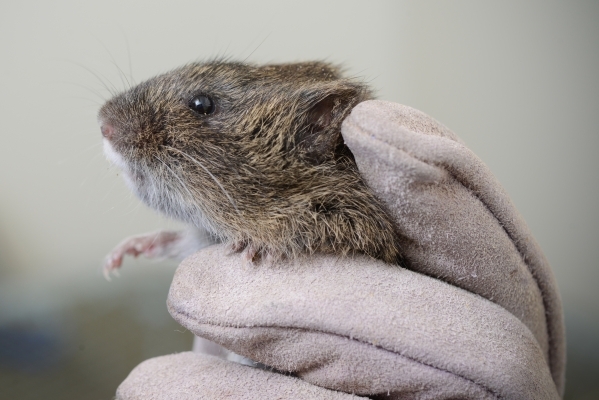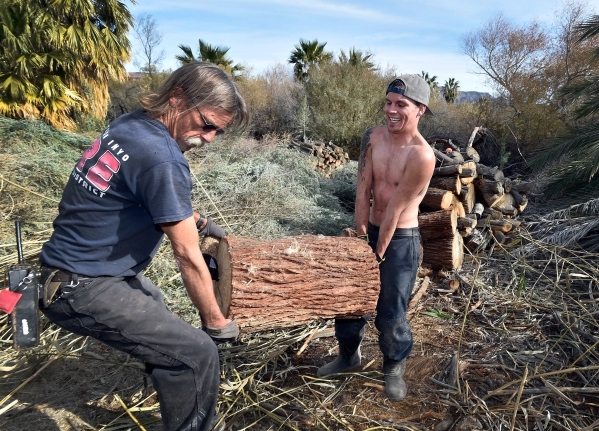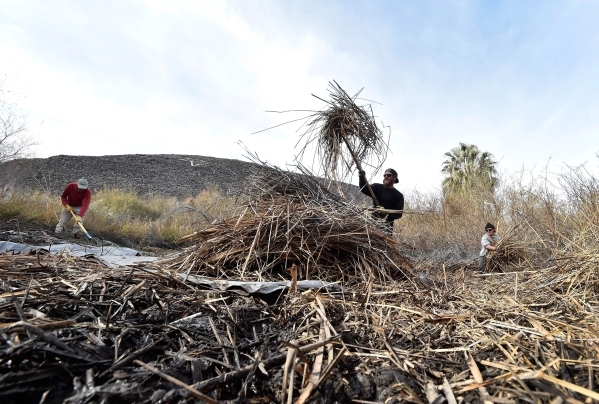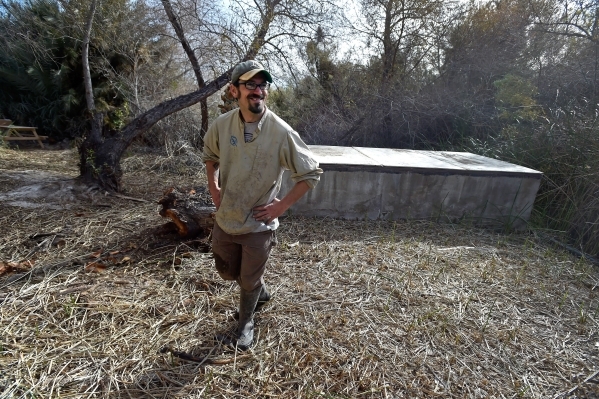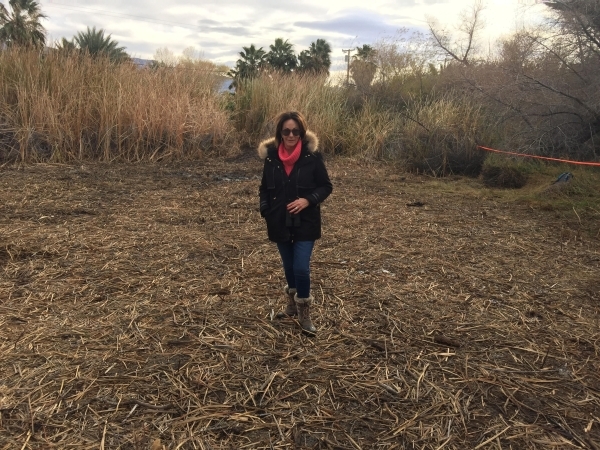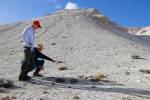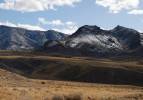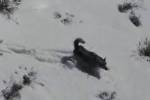Landowner opens her property to endangered Amargosa vole
SHOSHONE, Calif. — Some landowners would be alarmed — even angry — to discover a federally protected species on their property.
Not Susan Sorrells.
The fourth-generation owner of this tiny tourist town 90 miles west of Las Vegas is literally opening her property to the Amargosa vole, one of North America's most endangered mammals.
In early December, about a dozen workers and volunteers cleared almost an acre of overgrown marshland between Shoshone's small school and its only swimming pool. They ripped out a cattail thicket 12 feet high and used a chainsaw to pare back gnarled mesquites, giant salt cedars and dense stands of arrowweed.
This spring, the work crew from the Amargosa Conservancy, a local preservation group Sorrells helped launch, plans to replant the spring-fed area with three-square bulrush, a native grass that greens up in the punishing summer heat and is the voles' preferred food, shelter and breeding ground.
If the bulrush takes off, a handful of captive-born voles could be set free in the new habitat as early as spring of 2017 — a triumphant return for a small rodent that was wiped out here at least half a century ago.
"It's a grand experiment, and I'm just really excited about it," Sorrells said.
'Little lions' in a flood
According to some federal estimates, there may be as few as 150 Amargosa voles left in the wild.
"That's vastly fewer than almost any other endangered species that's in emergency status," said Janet Foley, a veterinary professor at the University of California, Davis.
Foley is co-leader of the "vole team," a species recovery group that includes the U.S. Fish and Wildlife Service, Bureau of Land Management, U.S. Geological Survey, California Department of Fish and Wildlife, UC Davis, the University of California, Berkeley and the Amargosa Conservancy.
The small, brown rodent with the round body and distinctive white beard was first described by naturalists in the late 1800s, but destruction of its native marshes by early settlers just east of Death Valley led scientists to declare the animal extinct in the early 1900s.
The species was rediscovered in the late 1970s and listed as endangered by the state of California and the federal government in the early 1980s.
Efforts to save the vole have acquired new urgency in recent years, as drought and human disturbance led to the destruction of most of the rodent's core habitat around Tecopa, Calif. That prompted an emergency collection of 20 juvenile voles in July 2014 amid concern the species could be gone forever in as little as a year.
Those voles have been breeding at UC Davis since, building a captive population now approaching 100 animals.
"The colony is doing great," Foley said. "The animals are easy, and they breed like rodents."
But researchers still have a lot to learn about the species.
In June, Foley and company released a dozen captive-bred voles into the wild for the first time. At least two of those animals appear to have starved to death, possibly as a result of being harassed by fellow voles to the point that they simply stopped eating.
"They're very docile in cages, but when we take them outside they're more like little lions. They're much more aggressive," Foley said.
The next time around, she said, they plan to release fewer animals at a time to limit such aggression and territorial disputes.
Researchers recently learned something else interesting about the vole: They know what to do in a flash flood.
After storms raked the area in October, a vole the team was tracking turned up in a different marsh downstream. Foley believes the animal swam there or caught a ride on some floating debris.
"There's no other possibility. We've never seen them move before," she said. "It seems this is a species that knows how to deal with floods."
Building a new lifeboat
As resilient as it may be, the vole could still be wiped from existence by a single event — be it flood, fire or drought.
That's why the work now underway on Sorrells' property in Shoshone could prove so important, said Patrick Donnelly, executive director of the Amargosa Conservancy. If they succeed in creating a healthy habitat, they will have built a potential new lifeboat for the species.
"No one's really done this before. We are very much learning by doing on this project," Donnelly said.
The first step was clearing land to "create a blank canvas," he said. Next up is growing some bulrush in nearby greenhouses to be transplanted in the spring.
Luckily, the plant is easy to cultivate, Donnelly said.
"If you have heat and water basically you can't stop it. It will grow," he said.
Once the bulrush is planted, the area will require constant monitoring and maintenance.
"We'll be out here literally every week yanking out cattails and keeping the mesquite cut back," Donnelly said.
Sorrells knows the land better than anyone. She played there as a child, building forts under the willow trees and hiding in the tall stands of arrowweed.
And she's already had success there as a steward of endangered species.
The Shoshone pupfish was thought to be extinct until 1986, when a small population was discovered in the outflow from the springs on Sorrells' land. A short time later, Sorrells and her husband, Robby Haines, teamed with researchers to launch a restoration effort using a single pond and 75 fish netted from the stream.
Today there are 4,000 to 5,000 pupfish living in man-made ponds in Shoshone. Many of those ponds are surrounded by healthy green stands of bulrush that could one day harbor voles, too, Donnelly said.
"She's totally violating the paradigm. She is willingly introducing this endangered species to her property," he said of Sorrells. "She's a real hero."
A habitat for humans, too
There is also an element of atonement at play.
"It might have been my great-grandfather who cleared that whole hillside to grow alfalfa and ran off the voles," Sorrells explained.
R.J. "Dad" Fairbanks was a freighter who ran a mule team into Death Valley in the late 1800s. He founded the town of Shoshone on the site of the springs where he would feed and water his animals. The land has been in the family ever since.
"It's just a privilege to live there," Sorrells said.
But as much as she is rooting for the voles, she has a larger goal in mind. She isn't interested in creating a zoo for a single species. She wants her property to be an oasis and a refuge for a wide variety of native wildlife, including humans.
"It irks me when people are made out to be part of the problem and they're alienated from nature," Sorrells said.
That will require the architects of the new habitat to strike a balance between what the voles need and what the land already has to offer to other rare species — including the pupfish and endangered birds such as the least Bell's Vireo and the southwest willow flycatcher — all while carving out space for walking paths, bird trails and interpretive signs.
Sorrells doesn't think it will be a problem. After all, Mother Nature has already done most of the heavy lifting.
"We're recreating a habitat that has nourished all of these creatures for hundreds of years," she said. "We need to let the land speak to us."
As for the possibility of losing control of the project or seeing her land tied up in regulatory red tape, Sorrells isn't worried. She said she has worked with members of the vole team for years and they have all become trusted friends.
Just in case, though, she has entered what's known as a "safe harbor agreement" with the Fish & Wildlife Service so she can host a federally protected species on her land without limiting her use of it in the future.
"I feel completely safe about this, and it's creating a great ecotourism opportunity for us," Sorrells said. "We have a good shot at really doing groundbreaking work on habitat restoration. Now the work continues."
— Contact Henry Brean at hbrean@reviewjournal.com or 702-383-0350. Follow him on Twitter: @RefriedBrean





